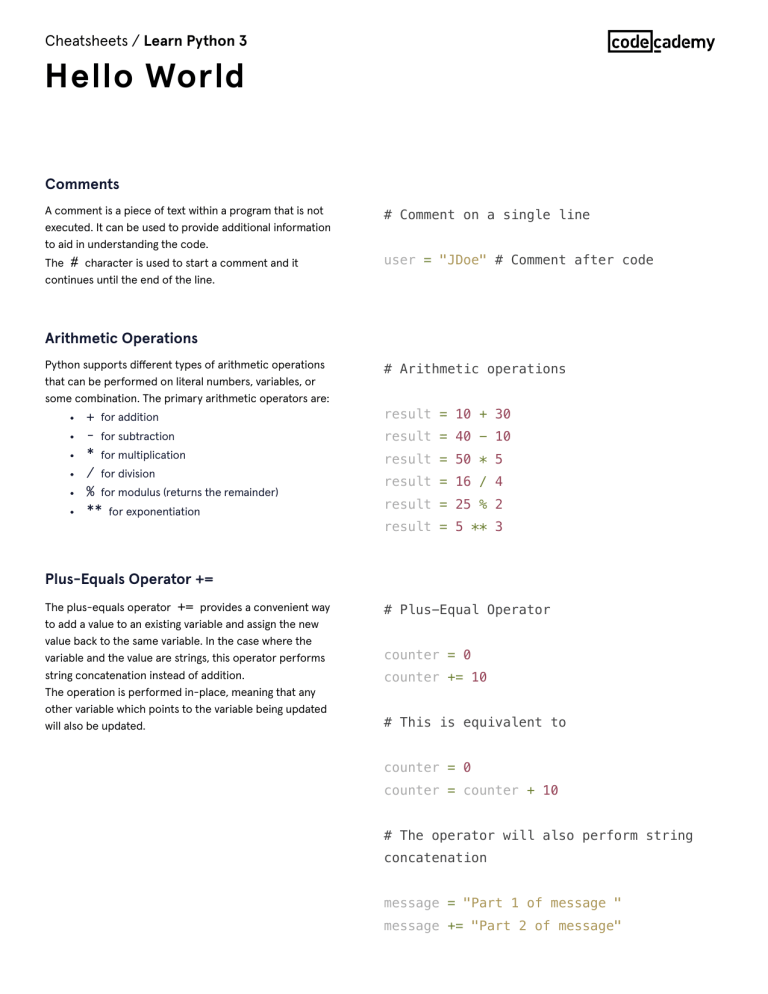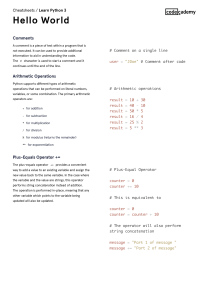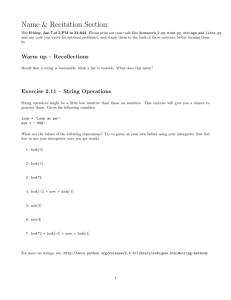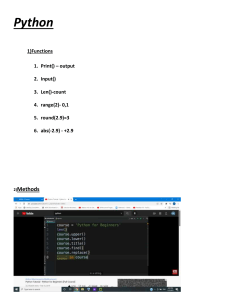Python 3 Cheatsheet: Hello World & Basics
advertisement

Cheatsheets / Learn Python 3 Hello World Comments A comment is a piece of text within a program that is not executed. It can be used to provide additional information to aid in understanding the code. # Comment on a single line The # character is used to start a comment and it continues until the end of the line. user = "JDoe" # Comment after code Arithmetic Operations Python supports different types of arithmetic operations # Arithmetic operations that can be performed on literal numbers, variables, or some combination. The primary arithmetic operators are: + for addition - for subtraction * for multiplication / for division % for modulus (returns the remainder) ** for exponentiation result = 10 + 30 result = 40 - 10 result = 50 * 5 result = 16 / 4 result = 25 % 2 result = 5 ** 3 Plus-Equals Operator += The plus-equals operator += provides a convenient way to add a value to an existing variable and assign the new value back to the same variable. In the case where the variable and the value are strings, this operator performs string concatenation instead of addition. The operation is performed in-place, meaning that any other variable which points to the variable being updated will also be updated. # Plus-Equal Operator counter = 0 counter += 10 # This is equivalent to counter = 0 counter = counter + 10 # The operator will also perform string concatenation message = "Part 1 of message " message += "Part 2 of message" Variables A variable is used to store data that will be used by the program. This data can be a number, a string, a Boolean, a list or some other data type. Every variable has a name which can consist of letters, numbers, and the underscore character _ . The equal sign = is used to assign a value to a variable. After the initial assignment is made, the value of a variable can be updated to new values as needed. # These are all valid variable names and assignment user_name = "codey" user_id = 100 verified = False # A variable's value can be changed after assignment points = 100 points = 120 Modulo Operator % A modulo calculation returns the remainder of a division # Modulo operations between the first and second number. For example: The result of the expression 4 % 2 would result in the value 0, because 4 is evenly divisible zero = 8 % 4 by 2 leaving no remainder. The result of the expression 7 % 3 would return 1, because 7 is not evenly divisible by 3, leaving a remainder of 1. nonzero = 12 % 5 Integers An integer is a number that can be written without a fractional part (no decimal). An integer can be a positive number, a negative number or the number 0 so long as there is no decimal portion. # Example integer numbers The number 0 represents an integer value but the same tables = 1 number written as 0.0 would represent a floating point number. chairs = 4 broken_chairs = -2 sofas = 0 # Non-integer numbers lights = 2.5 left_overs = 0.0 String Concatenation Python supports the joining (concatenation) of strings together using the + operator. The + operator is also used for mathematical addition operations. If the # String concatenation parameters passed to the + operator are strings, then first = "Hello " concatenation will be performed. If the parameter passed second = "World" to + have different types, then Python will report an error condition. Multiple variables or literal strings can be joined together using the + operator. result = first + second long_result = first + second + "!" Errors The Python interpreter will report errors present in your if False ISNOTEQUAL True: code. For most error cases, the interpreter will display the line of code where the error was detected and place a caret character ^ under the portion of the code ^ SyntaxError: invalid syntax where the error was detected. ZeroDivisionError A ZeroDivisionError is reported by the Python interpreter when it detects a division operation is being performed and the denominator (bottom number) is 0. In mathematics, dividing a number by zero has no defined numerator = 100 denominator = 0 bad_results = numerator / denominator value, so Python treats this as an error condition and will report a ZeroDivisionError and display the line of code where the division occurred. This can also happen if a variable is used as the denominator and its value has ZeroDivisionError: division by zero been set to or changed to 0. Strings A string is a sequence of characters (letters, numbers, whitespace or punctuation) enclosed by quotation marks. It can be enclosed using either the double quotation mark " or the single quotation mark ' . If a string has to be broken into multiple lines, the backslash character \ can be used to indicate that the string continues on the next line. user = "User Full Name" game = 'Monopoly' longer = "This string is broken up \ over multiple lines" SyntaxError A SyntaxError is reported by the Python interpreter when some portion of the code is incorrect. This can include misspelled keywords, missing or too many brackets or parentheses, incorrect operators, missing or too many quotation marks, or other conditions. age = 7 + 5 = 4 File "<stdin>", line 1 SyntaxError: can't assign to operator NameError A NameError is reported by the Python interpreter when misspelled_variable_name it detects a variable that is unknown. This can occur when a variable is used before it has been assigned a value or if a variable name is spelled differently than the point at NameError: name 'misspelled_variable_name' which it was defined. The Python interpreter will display the line of code where the NameError was detected and is not defined indicate which name it found that was not defined. Floating Point Numbers Python variables can be assigned different types of data. One supported data type is the floating point number. A # Floating point numbers floating point number is a value that contains a decimal portion. It can be used to represent numbers that have pi = 3.14159 fractional quantities. For example, a = 3/5 can not meal_cost = 12.99 be represented as an integer, so the variable a is assigned a floating point value of 0.6 . tip_percent = 0.20 print() Function The print() function is used to output text, numbers, or other printable information to the console. print("Hello World!") It takes one or more arguments and will output each of the arguments to the console separated by a space. If no print(100) arguments are provided, the print() function will output a blank line. pi = 3.14159 print(pi) Print Share




